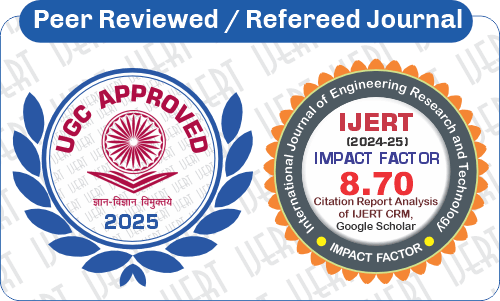 DOI : 10.17577/IJERTV3IS110323
DOI : 10.17577/IJERTV3IS110323
- Open Access

- Total Downloads : 250
- Authors : Gayatri Ajit, Hari G
- Paper ID : IJERTV3IS110323
- Volume & Issue : Volume 03, Issue 11 (November 2014)
- Published (First Online): 11-11-2014
- ISSN (Online) : 2278-0181
- Publisher Name : IJERT
- License:
 This work is licensed under a Creative Commons Attribution 4.0 International License
This work is licensed under a Creative Commons Attribution 4.0 International License
To Study the Variation in Coefficient of Consolidation after installation of Sand Compaction Piles
Gayatri Ajit Hari G
Mtech Geomechanics and Structures Professor, Dept. of Civil Engg SAINTGITS College of Engineering, SAINTGITS College of Engineering,
Kottayam, Kerala, India. Kottayam, Kerala, India.
Abstract-Sand compaction piles are installed in soft cohesive soils to improve the bearing capacity and to reduce the settlement. The behavior of clayey soils after installation of sand compaction piles have to be analyzed for ensuring the stability and safe functioning of clayey soil. In the present work we conducted a series of laboratory tests to understand the variation in coefficient of consolidation. Sand compaction piles are modeled in soils in which the sand and clay content used are varied in different percentages.(eg: 80% sand and 20% clay , 60% sand and 40% clay etc) and the variation in coefficient of consolidation value is studied.
I.INTRODUCTION
Due to increasing developments in coastal areas in recent past a number of harbors, industries and other infrastructures are being constructed. Usually we go for pile foundation in these areas which meets all the design requirements. Since the cost of pile foundation is very high we have to find out other methods for construction in these areas. Ground improvement methods can be done for achieving economy in construction. One among such methods is sand compaction pile method ( SCP ). This method improves the soil layers by introducing a certain number of properly compacted sand columns into soil by which the reinforcement and strength of soil improves. This method is a very cost effective method compared to other methods like grouting and chemical treatment. The ground becomes more stable, bearing capacity increases and settlement is reduced when sand compaction piles are constructed.
The behavior of clayey soils after installation of sand compaction piles have to be analyzed for ensuring the stability and safe functioning of clayey soil. In the present work the behavior of clayey soil reinforced using sand compaction piles have been evaluated through laboratory tests. Here we conduct a series of laboratory tests to understand the variation in coefficient of consolidation (consolidation test) .Sand compaction piles are modeled in soils in which the sand and clay content used are varied in different percentages.(eg: 80% sand and 20% clay , 60% sand and 40% clay etc) and the variation in coefficient of consolidation is studied.
-
MATERIALS USED
The two basic materials used for the study were clay which represents the soft soil to be improved and sand, the sand compaction pile forming material. The properties of each of these are as follows:
-
Soft clay
Soft clay used for the experiment was collected from the Puthupally area near Kottayam. The load carrying capacity of soil obtained from this area is very less. Both disturbed as well as undisturbed samples were obtained from field depending upon the laboratory tests to be conducted. Several laboratory tests like triaxial test, light compaction test, UCC test, Hydrometer test etc were conducted and the initial properties of clay were determined as in the table given below.
FIELD DENSITY
16.2 kN/m3
SPECIFIC GRAVITY
2.06
MOISTURE CONTENT
79.22%
UCC TEST RESULTS
COHESION
8.24 kN/m2
UNCONFINED COMPRESSIVE
16.48 kN/m2
STRENGTH
TRIAXIAL TEST RESULTS MODULUS OF ELASTICITY COHESION
ANGLE OF INTERNAL FRICTION
POISONS RATIO
1208.33 kN/m2
11.25 kN/m2
4
0.47
PERCENTAGE OF CLAY
PARTICLES
9.9%
PERCENTAGE OF SILT PARTICLES
71.59%
D10
0.0021 mm
TABLE I. PROPERTIES OF CLAY
D30
0.022 mm
MAXIMUM DRY DENSITY
1.4 gm/cm3
OPTIMUM MOISTURE CONTENT
29.1 %
LIQUID LIMIT
83 %
FLOW INDEX
21.87 %
PLASTIC LIMIT
71.59 %
PLASTICITY INDEX
11.41 %
TOUGHNESS INDEX
0.52
SHRINKAGE LIMIT
62.66 %
COEFFICIENT OF
COMPRESSIBILITY
0.136 cm2/kg
COEFFICIENT OF VOLUME
CHANGE
5.46 X 103 cm2/kg
COMPRESSION INDEX
0.664 cm2/kg
-
Sand
Fine sand passing through IS 425 micron sieve was used to form the sand compaction pile. Locally available sand was collected and sieved to obtain the required particle size distribution. Properties of the sand are presented in the table .
TABLE II.PROPERTIES OF SAND
DENSITY ( 425 microns passing )
3
16.2 kN/m
COHESION ( 425 microns passing )
2
2.5 kN/m
FRICTION ( 425 microns passing )
290
SPECIFIC GRAVITY ( 425 microns passing )
2.67
UNIFORMITY COEFFICIENT
2.42
COEFFICIENT OF CURVATURE
1.401
PERCENTAGE OF COARSE FRACTION
99.483 %
-
-
TO STUDY THE VARIATION OF COEFFICIENT OF CONSOLIDATION ( CONSOLIDATION TEST )
A New mould had to be designed for modeling the sand compaction piles in clay. Pictures of the mould and their specifications are given below. In addition to the parts shown in the figure filter paper, metallic tube of 1cm diameter and reservoir with rubber tube were also used for the experiment. The mould used for consolidation test is very small to model the sand compaction piles so we have designed a new mould for conducting the experiment. The experiment is performed in the same consolidation test apparatus. Procedure for test is as per IS : 2720 ( part 15 ). Load to be applied have to be recalculated. ( pressure changes with change in surface area of mould )
A.Parts of Mould
Fig 1. Top plate top portion
Fig 2. Top plate bottom portion
Fig 3. Top view of mould in which sand compaction piles are modeled
Mould details
Height of mould : 7cm Diameter of mould : 10 cm
Sand compaction piles provided : 9 numbers Spacing of sand compaction piles provided : 3 cm Height of clay layer provided : 3.5 cm
Diameter of sand compaction pile : 1 cm
-
Preparation of soft clay bed for consolidation test
The clay bed for the tests were prepared in the mould designed. The thickness of clay layer provided was 3.5 cm. Instead of two porous stones here we provided two sand layers of 1 cm thickness at top and bottom of clay layer for drainage, fine sand passing through IS 425 micron was used for this purpose. Filter papers were placed along with the sand layers in order to avoid the penetration of sand particles into the clay layer. The soil sample was compacted according to field density of clay. The soft clay bed was repared by pouring the clay in layers. Clay was thoroughly mixed and filled in the mould in layers by hand with measured quantity by volume. The surface of each layer was compacted properly to attain uniform density. Care was taken to prevent the formation of air voids in the clay bed. For every consolidation test, the clay bed was prepared in the mould by this method and the sand compaction piles were installed in it.
Fig.4.Sand bed prepared for providing sand compaction piles
-
Construction of Sand Compaction Pile
All the tests were conducted on clay reinforced with sand compaction piles. In case of consolidation test nine sand compaction piles were provided in the clay bed at a spacing of 3 cm.
A metallic pipe having an outer diameter equal to the diameter of the sand compaction pile was used to install the piles. The metallic pipe was pushed into the soil till the bottom of the clay layer. When the metallic pipe is pulled out, the clay in that particular area gets removed. The pipe
is gently inserted into the soil so as to minimize the disturbance in the clay soil that may change the properties of the clay after reinforcement. Thus number of holes required for construction of sand compaction piles were made in this manner.
The quantity of sand required to form the sand pile was premeasured and charged into the hole in layers. Each layer was compacted to achieve uniform field density. The soil was filled to the entire height and the sand compaction pile of required density was obtained. The same process can be repeated to construct the required number of sand compaction piles.( fine sand passing through IS 425 micron was used)
Fig 4. Arrangement of Sand compaction piles for consolidation test
D .Laboratory test procedure: consolidation test
After preparing the sand compaction piles, the variation of coefficient of consolidation value was determined by conduction one dimensional consolidation test in laboratory. The tests were performed in consolidation test apparatus by means of a loading frame. The pressure applied can be varied by varying the weights used for the tests. Standard pressures applied are 0.125 kg/cm2,0.25 kg/cm2, 0.5 kg/cm2, 1 kg/cm2, 2 kg/cm2 etc. Pressure applied depends on the area of specimen. Since the area of the mould which we have used is approximately 3 times more than the actual consolidation testing mould, in order to attain 0.125kg/cm2 in our mould we need to apply 3 times 0.125kg/cm2 which will be equal to 0.375kg/cm2. For different pressures dial gauge reading is noted for different time intervals (0, 0.25, 1, 2.25, 4, 6.25,
9, 12.25, 16, 20.25, 25, 36, 49, 64, 81, 100, 121, 144, 169,
196, 225 etc minutes).Graph for dial gauge reading vs time is plotted (Y and X axis respectively ).From this graph coefficient of consolidation is determined by root time method.
TABLE III. LIST OF EXPERIMENTS TO BE CONDUCTED SAMPLE WITH/WITHOUT TYPE PRESSURE
1)100% CLAY
WITH SAND
DISTURBED
0.125
COMPACTION
0.25
PILES
0.316
0.5
2)100%CLAY
WITH SAND
UNDISTURBED
0.125
COMPACTION
0.25
PILES
0.316
0.5
3)80%CLAY
WITH SAND
DISTURBED
0.125
& 20% SAND
COMPACTION
0.25
PILES
0.5
0.625
4)60%CLAY
WITH SAND
DISTURBED
0.133
& 40% SAND
COMPACTION
0.34
PILES
0.54
0.866
5)40% CLAY
WITH SAND
DISTURBED
0.14
& 60% SAND
COMPACTION
0.3
PILES
0.67
1
6)20%CLAY
WITH SAND
DISTURBED
0.166
& 80% SAND
COMPACTION
0.66
PILES
1
1.5
7)100% SAND
DISTURBED
0.25
0.5
1
2
SCP kg/cm2
Fig 5. Consolidation test performed in laboratory using the new mould
-
-
RESULTS
TABLE IV.VARIATION IN CV VALUE
100% CLAY
1
PRESSURE
2
(kg/cm )
90
(min)
t90 min
D
(mm)
Cv cm2/min
0.125
9
81
17.42
0.0317
0.25
8
64
17.3
0.039
0.316
7.3
53.29
17.18
0.046
0.5
6.6
43.56
17.04
0.056
100% CLAY
2 PRESSURE
90
t90
D
Cv
0.125
8.7
75.69
17.42
0.033
0.25
8
64
17.26
0.039
0.316
7.2
51.84
17.14
0.048
0.5
6.5
42.25
17.02
0.058
80 % CLAY PRESSURE
90
t90
D
Cv
0.125
8
64
17.39
0.04
0.25
7.4
54.76
17.211
0.045
0.5
6.4
40.96
17.048
0.06
0.625
6
36
16.92
0.067
60% CLAY PRESSURE
90
t90
D
Cv
0.133
7.1
50.41
17.4
0.05
0.34
6.3
39.69
17.21
0.06
0.54
5.6
31.36
17.05
0.078
0.866
5.3
28.09
16.84
0.0856
40% CLAY PRESSURE
90
t90
D
Cv
0.14
6.5
42.25
17.425
0.06
0.3
6.1
37.21
17.27
0.067
0.67
5.5
30.25
17.027
0.081
1
5
25
16.76
0.09
20% CLAY PRESSURE
90
t90
D
Cv
0.166
5.4
29.16
17.35
0.0875
0.66
4
16
17.11
0.155
1
3.6
12.96
16.92
0.187
1.5
3
9
16.6
0.241
100% SAND PRESSURE
90
t90
D
Cv
0.25
4.6
21.16
17.325
0.12
0.5
4.1
16.81
17.01
0.145
1
3.3
10.89
16.5
0.212
2
2.9
8.41
15.625
0.246
A. Graphical representation of results
X axis : pressure in kg/cm2 Y axis : Cv cm2/min
Fig.6.1. 100% clay 1 and 0% sand
Fig.6.2.100% clay 2 and 0% sand
Fig.6.3. 80% clay and 20% sand
Fig.6.4. 60% clay and 40% sand
Fig.6.5. 40% clay and 60% sand
-
For 100% sand approximate Cv value obtained was 0.2 cm2/min for the pressure range in which experiment was conducted ( 0.25 to 2 kg/cm2 ) shear failure was not observed even after applying 4 kg/cm2 pressure.
-
Cv values obtained from the test can be used for approximate calculations for practical problems in field depending upon the soil types.
ACKNOWLEDGEMENTS
This work was done in Advanced Geotechnical Engineering labortory of Saintgits College of Engineering, Pathamuttom, Kottayam.
I thank Professor Hari G , Department of Civil Engineering , Saintgits College of Engineering , for the guidance given in each and every move of this work. I also express my sincere gratitude to everyone in the civil engineering department , Saintgits College of Engineering,Pathamuttom, Kottayam for their whole hearted cooperation.
REFERENCES
Fig.6.6. 20% clay and 80% sand
Fig.6.7. 0% clay and 100% sand
-
-
CONCLUSIONS
The following conclusions can be drawn from the present study
-
Cv value increased when the % of sand content of the soil sample incresed.
-
For 100 % clay approximate Cv value obtaied was 0.04 cm2/min for the pressure range in which experiment was conducted ( 0.125 to 0.5 kg/cm2)
Shear failure occurred when pressure more than 0.6 kg/cm2 was applied.
-
IS 2720 ( part III SEC-1 ) 1980 Indian standard methods of test for soils, Part iii determination of specific gravity, Section 1 fine grained, Bureau of Indian Standards, New Delhi.
-
IS 2720 ( part 4 ) 1985 Indian standard methods of test for soils, Grain Size Analysis, Bureau of Indian Standards, New Delhi
-
IS 2720 ( part 5 ) 1986 Indian standard methods of test for soils, determination of Liquid Limit and Plastic Limit , Bureau of Indian Standards, New Delhi.
-
IS 2720 ( part 6) 1986 Indian standard methods of test for soils, determination of Shrinkage Limit, Bureau of Indian Standards, New Delhi.
-
IS 2720 ( part 7) 1980 Indian standard methods of test for soils, determination of determination of water content-dry density relation using light compaction, Bureau of Indian Standards, New Delhi.
-
IS 2720 ( part 10) 1991 Indian standard methods of test for soils, determination of Unconfined compressive strength, Bureau of Indian Standards, New Delhi.
-
IS 2720 ( part 11) 1993 Indian standard methods of test for soils, determination of the shear strength parameters of a specimen tested in unconsolidated undrained triaxial compression without the measurement of pore water pressure, Bureau of Indian Standards, New Delhi.
-
IS 2720 ( part 15) 1986 Indian standard methods of test for soils, determination consolidation properties, Bureau of Indian Standards, New Delhi
-
IS : 2720 ( part 13 ) 1986 Indian standard methods of test for soils part 13 direct shear test
-
By Ashraf Kamal Nazir and Wasim R Azzam, Improving the bearing capacity of footing on soft clay with sand pile, Alexandria Engineering Journal January 2011
-
N. H. Priyankara, Evaluation of mechanical properties of scp composite ground, Proceedings , conference at University of Ruhuna, Galle
-
Z.C.Moh , C.D.Ou , S.M.Woo and K.Yu ,Compaction sand piles for soil improvement , Proceedings , X international conference on Soil Mechanics and Foundation Engineering,Stockholm,1981,vol.3
-
Sahand Moshirian, .Behaviour of compaction piles made from reinforced sand fines ,Proceedings , conference at School of Civil Engineering, The University of Birmingham, UK
-
Richard D Barksdale, State of the art for design and construction of sand compaction piles, Repair , Evaluation , maintenance and rehabilitation research program , technical report REMR-GT-4 1986
-
B. S. Chun, Y. H. Yeoh, M. Sagong, and K. M. Kim, Reduction of settlement due to sand pile installation, Proceedings , A2K0 4Annual Committee meeting on Substructure Soil-Structure Interaction Submission Date : November 15, 2002




